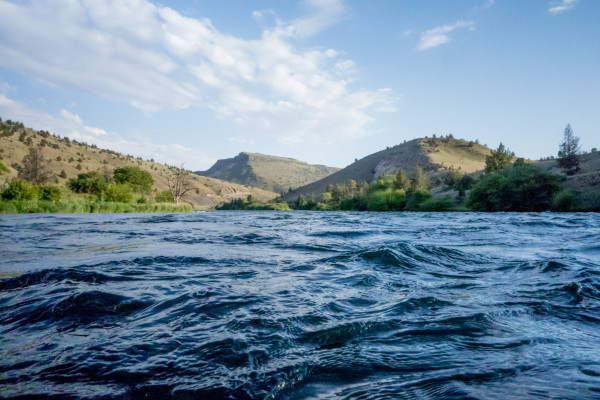Background
With a strong source of ground water, the Deschutes is a magnificent salmon, trout, and steelhead stream. This river is an important destination for anglers from around the world and it is the center for the Warm Springs Tribes and their fisheries.
The one hundred miles of river below Pelton Dam are all that remain to support sea-run fish that migrate up the Columbia River from the sea. These fish must pass two main stem hydro dams on the Columbia twice, initially as juveniles and again as adults – a hazardous trip indeed.
The productive fish capacity of the Deschutes has been blocked by large dams on the Crooked River and on the main stem by the Pelton Round Butte Hydropower Complex. There are only a few tributaries suitable for steelhead spawning below the dams, and most are ephemeral — they dry up in the summer. On wet years they flow from late February through the first few weeks of June. The steelhead adults migrate up these streams to spawn and the smolts leave them for the main river.
The only wild spring chinook remaining in the Deschutes are found in the Warm Springs River, a tributary that lies wholly within the Warm Springs Tribal lands. These fish are carefully protected by the tribes, and no hatchery fish are allowed to spawn naturally upstream of the hatchery.
Surviving wild steelhead face poor condition of its few spawning tributaries due to water use, cattle grazing, and from stray hatchery fish that spawn naturally in the river and its tributaries. Harvest presents another problem since the fish are taken in Columbia River fisheries as well as in the Deschutes. However, many anglers release their fish in the Deschutes. The trout regulations have been shaped to protect young fish, including juvenile anadromous fish, as well as older, larger native trout.
The Native Fish Society has had a long history with this river and was successfully encouraged ODFW to adopt a slot limit, which protects native trout, juvenile salmon and steelhead. There are many issues to be resolved including habitat recovery on tributaries, eliminating stray hatchery steelhead from natural spawning areas, mainstem passage, wild steelhead kelt survival and harvest.
Threats:
Perhaps the most significant challenge, and opportunity, facing the Lower Deschutes is the change in management of water released from the Pelton/Round Butte Hydropower Complex as part of an ongoing project to improve anadromous fish passage around the dams. This 100 million plus dollar project was conceived and implemented over the past 10 years as a condition of relicensing of the dams. Stakeholders involved in the project include Portland General Electric, the Confederated Tribes of the Warm Springs, and five conservation organizations including NFS. Attempts to improve anadromous fish passage in both directions (summer steelhead, spring chinook and sockeye salmon) have lead to observed changes in Lower Deschutes water quality (temperature, pH, dissolved oxygen, nutrients etc.), insect and plant life, and fish populations. This fluid situation will require ongoing monitoring and adaptive management to ensure water quality and native fish health improve.
